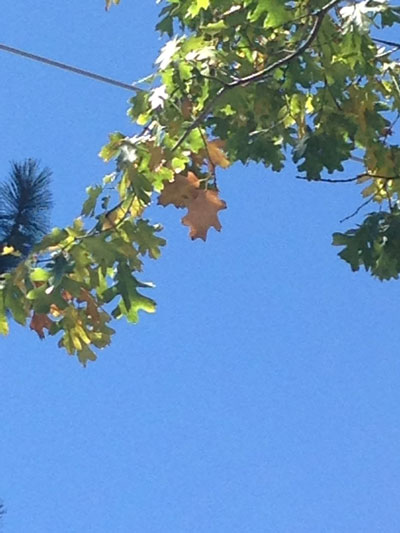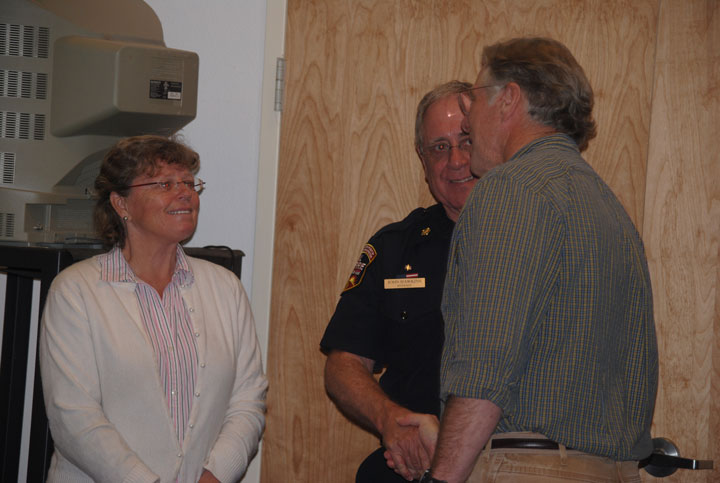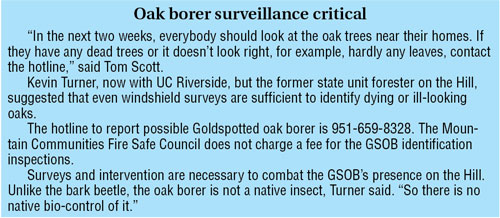Since confirming the first oak tree infested with Goldspotted oak borers, another 20 oaks have been identified, according to Gregg Bratcher, Cal Fire unit forester on the Hill. While the apparent presence of the beetle is still far from the level of devastation it has inflicted in San Diego County, forest officials are still worried about its spread.
The GSOB was a principal topic during last week’s Mountain Area Safety Taskforce meeting.
“Thus far, Forest Service still has found nothing on the national forest,” reported Kevin Turner, GSOB coordinator for University of California Agricultural and Natural Resources at UC Riverside. “But this summer, new discoveries were made in eastern San Diego County.”
Not only did Bratcher and Turner emphasize that property owners and visitors should still be very careful about bringing oak firewood to the Hill, they also advised that caution should be taken about taking oak off the Hill.
In a conference call later in the day, Turner said the GSOB Steering Committee at the University of California, Davis, was investigating using California Penal Code section 384.5 as a model for tracking firewood movement.
The existing statute requires a permit from the property owner, including the federal government, from where the wood was acquired, and the name of the purchaser.
“This would be a good model for firewood orders to track from cutting to where sold,” Turner explained. “It would track the origin and any treatment.”
As fall proceeds, both men said the possibility of identifying more infected trees may be better. Leaves on the sick and dying trees will be brown, not yellow, and remain on the tree rather than falling.
Property owners are encouraged to call the GSOB hotline at 951-659-8328 to report trees or request an inspection. The Mountain Communities Fire Safe Council has several trained inspectors who have been active throughout the community since spring.
“The Fire Safe Council’s Woodies have been really good identifying these trees,” Bratcher said. Since spring, FSC volunteers have inspected nearly 450 oaks, dedicating nearly 300 hours of their time to the community’s safety, reported Chris Kramer, FSC 1st vice president.
Several hotspot areas have been identified, according to Bratcher. One is Marion View Drive near Crest View. A second is along South Circle Drive in the Darryl Road area. A third hot spot is near Saunders Meadow and Castle Rock.
Identified trees have been cut down and the wood removed. “It’s prudent to take down any newly identified trees,” Turner told the group.
“If we take the tree down at our cost, we’ll take the tree to the grinding station,” Bratcher stated.
Early in the San Diego County infestation, property owners were allowed to keep a cord of firewood. “Invariably the tarps and coverings came loose,” Turner said, indicating that officials believe this has contributed to the GSOB’s eastward movement. “In hindsight, they discourage this.”
GSOB has now been discovered on the Pacific Coast in La Jolla. Turner also attributed this movement to weaker controls on cut wood in the past.
In response to a question about the possibility of spraying the infected trees, Turner replied, “We have no recommendation. But registered pesticide appliers are listed on our website.” He stressed that they must be licensed with Riverside County. Visit http://ucanr.edu/sites/gsobinfo/Resources/By_County/Riverside_County/Licensed_Pest_Control_Operators-Riverside_County/.
Cal Fire has approached the state Board of Forestry to expand the current zone of infestation to include Riverside County and the Hill specifically. In September 2012, the board designated 1.1 million acres in San Diego County as GSOB-infested. This action formally recognized the GSOB as a threat to California’s forest and woodland resources.
In other GSOB-related news, Mike Feyder, Idyllwild Mountain Disaster Preparedness president, reported that the Idyllwild Garden Club was producing 10 more signs warning drivers about bringing oak firewood to the Hill and five will be in Spanish.
Mighty oaks from acorns
Replacing the lost oaks from the Goldspotted oak borer attack was the subject of a conference call last week for the GSOB Steering Committee.
How to grow mighty oaks from acorns to replenish the lost trees was the subject Dr. Tom Scott, University of California, Riverside, discussed with an online audience. “It’s the season to collect acorns and do what we can for restoration,” he began.
While acorns can be collected from the ground, now is the right time to harvest them directly from the tree because they will have the highest water content, according to Scott.
The trick is to determine which acorns are the most likely to germinate roots and grow. Scott recommends putting them in a container of water. The acorns that sink are the most viable. The acorns that float on the water’s surface should be discarded.
They float because air has gotten through the acorn’s surface into the core, thus potentially damaging the seedling nourishment.
After choosing the best acorns, place them in a damp and dark canvas bag for three days up to a week. Roots should begin to appear.
When planting acorns, Scott suggests areas where oaks have already been established. Selecting new areas may seem appealing, but there may be reasons that oaks have not grown there, he stressed.
The area will need to be weeded and maintained. Watering will be helpful and Scott suggests that it mimic a normal year — more in the winter and spring and less in the summer and fall.
Acorns will be the topic of a special event at the Idyllwild Nature Center from 10 a.m. to 1 p.m. Saturday, Oct. 12. There will be educational and fun learning opportunities for all. And former Forest Service Archaeologist Daniel McCarthy and consulting Archaeologist Leslie Mouriquand will discuss how acorns were part of the menu for native Californians.














